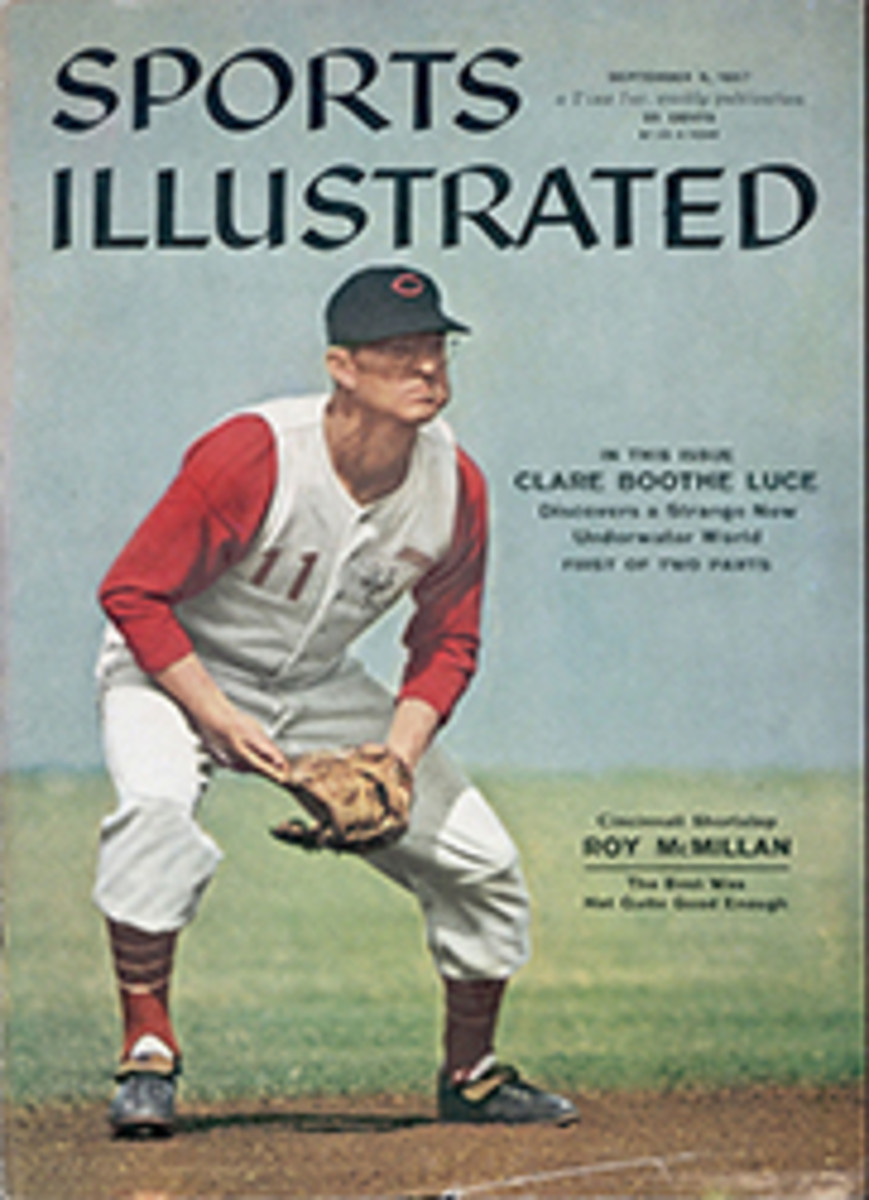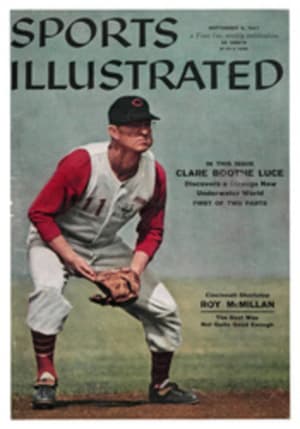
THE OLD MUG AGAIN
Two decades have passed since the majestic sloops known as the J boats spread their acres of gleaming canvas out under the sharp fall sun off Newport, R.I. to race for the most treasured sports trophy in history—the fanciful urn known as the America's Cup (above). The return of the great race is now imminent—and once again the Old Mug will stand as a prize for the best skipper of the biggest out-and-out racing design in sailing. The excitement generated, even though the boats will be somewhat smaller than the huge J boats, may well be enough to send 50,000 spectators to sea to watch the battle off Newport as in prewar days. There is no doubt that the top sports story of September 1958 will be the Old Mug's revival.
The particular and enduring fascination of the America's Cup races is easy to explain. By the time they reached the starting line each J boat had cost its owner at least a half million dollars and sometimes a great deal more. They ran 135 feet long, carried enough canvas to cover half a football field and had masts that raked higher than the Brooklyn Bridge. And these boats were perishable stuff, outmoded by the time the next series rolled around. "They had their fun and then they scrapped them," as one observer said.
With World War II, the day of the J boats was irrevocably past. Boatbuilding costs soared; racing craft in large sizes became far less popular than before. The America's Cup was almost forgotten. To many, its revival will seem a miracle.
THE FIRST STEP
The first step was to reduce the size of the class to be used in the races. Among others, Henry Sears, commodore last year of the New York Yacht Club, which holds the cup, was influential in persuading members that the tradition—which started in 1851 when the schooner America took the cup away from a fleet of British boats in the English Channel—could be honorably continued in smaller craft. Sears argued for an America's Cup series in the 70-foot, 12-meter class (see drawing on page 41) and won.
The British had been waiting for just such a decision. Over the 86 years of rivalry, British yachtsmen had spent more than $20 million to recover the cup without once getting it back. They were, in the British tradition, anxious for another crack at it.
The Royal Yacht Squadron's challenge—promptly accepted—arrived last May. They announced that Britain was building a brand-new 12-meter, Sceptre, to represent her.
Immediately there was an outbreak of impromptu conferences and meetings over here among those who could have been expected to raise part of the $150,000 to $250,000 needed to put a 12-meter into action. Several West Coast boat owners indicated interest. There was talk of a syndicate from Texas with oil money to spend, and of another group from the South which wanted to build a ship named Rebel. "The eliminations to pick the American defender will have a fine nationwide flavor," said one yachtsman.
Nothing of the sort happened.
After two months, not a single new American 12-meter had become definite, and the reasons were not hard to find. Briggs Cunningham, an ex-12-meter skipper who had been expected to participate, put it very succinctly. "Frankly, the expense just appalls me," said Cunningham. "I'm not enthusiastic enough about the 12-meter to get that financially interested. I don't see any way you're going to get your money's worth.
"Suppose," he continued, "you don't get picked to defend the cup. What are you going to do with the boat? They could have taken the ocean racing rule and ironed it out for the America's Cup racing. When you get through with an ocean racer you still have a good cruising boat instead of an absolutely useless item."
Over in England a London newsman predicted gloomily that "the cup races still have one foot in the grave and one on a banana peel."
Even Sparkman and Stephens, the naval architects whom Sears, on his own hook, had retained to test hull models, began to wonder if they were testing for a ghost ship and if reviving the cup had been "all wrong."
Then what can only be called the influence of the America's Cup began to work. In late summer, syndicates suddenly started springing up like a fleet of sails appearing over the horizon.
In Rumson, N.J., Henry D. Mercer, chairman of the board of States Marine Lines, and two business associates, Cornelius Walsh of Spring Lake, N.J. and Arnold Frese of Greenwich, Conn., announced they were putting up the capital for a 12-meter and retaining Philip Rhodes to do the design.
In Boston, almost at the same time, Chandler Hovey, who skippered the J boat Rainbow in 1937, formed a syndicate (so far composed only of himself) and hired C. Raymond Hunt to come up with plans for a 12-meter.
And finally, Henry Sears was in a position to give Sparkman and Stephens the assurance that their models would materialize into a ship. He had a syndicate to back him up now, with a member whose name was Briggs Cunningham.
"I did my best to keep out of this," said Cunningham, in explanation of his about-face, "but boats are not business. And Olin Stephens' design, which I think is potentially the fastest boat, by all odds, has the best chance."
Although Cunningham has not skippered a 12-meter since 1940, he has kept his hand in by winning national championships in the Atlantic class and will in all likelihood be at the wheel of the Sears boat next year.
On the design side, Sparkman and Stephens are doing their best to make Cunningham a prophet. They have gone to the testing tanks at Stevens Institute in Hoboken, N.J. and already have a couple of models in the water there. The last America's Cup defender, Ranger, was a tank-tested Sparkman and Stephens design that beat the challenger so badly it earned the name "super J boat." S. and S. will settle for nothing less than a super-12-meter this time.
Among the other American designers, Philip Rhodes for one is also working at Stevens' tanks, using models of the Mercer boat. Rhodes is a meticulous designer who, although he has a hundred draftsmen working for him, does a lot of his own basic drafting at home in his pantry at Pelham, N.Y. He has never designed to the meter rule, but his designs in other fields are world-famous. He recently did the 56-foot Caper, a sloop built to the cruising rule which took all the big boats in the 1957 Annapolis-Newport race.
C. Raymond Hunt, the third American designer, has the reputation for eccentric genius of a true New Englander. He is likely to hole up a hundred miles from salt water at his home in Tilton, N.H. and come out with something as extraordinary as the panatela-shaped 110 design, which all but revolutionized thinking in small boat sailing when it appeared in 1938. He has also been successful in working to the meter rule: his Quixotic was the fastest 5.5-meter boat in last year's Olympic trials and lost out only because the boat's mainsail came tumbling down in the final race (SI, Aug. 27, 1956).
In addition, Hunt is one of the sharpest skippers around. His new cruising sloop Harrier has been the outstanding racer on the East Coast this year, taking seven out of eight events entered. So there is little doubt Hunt will be given the chance to sail the Hovey boat himself.
Of the half dozen 12-meters now afloat in the U.S., only Harold S. Vanderbilt's famous old Vim, now owned by John N. Matthews of Oyster Bay, N.Y. can run with the boats currently being built. Matthews should have the best-trained crew. While Vim, which had been fitted as a cruising boat, is being "skinned out and lightened up," Matthews has started to train his men on the old Nyala and seems to be having good luck. The Nyala took two Class A races in the New York Yacht Club cruise.
Meanwhile, back in England, the British are going about the making of the challenger in an assured and methodical manner. Four architects submitted models to the Royal Yacht Squadron syndicate which is building Sceptre, and the best-performing model (built by Scotsman David Boyd) was picked. The economy-minded British came to the conclusion that it would be preferable to match models rather than full-size ships.
On this side of the Atlantic, Chandler Hovey was moved by this display of British efficiency to make what might be called a keynote speech for all the owners, designers and yachtsmen who are by now inextricably involved in the 1958 America's Cup. "The winner of the elimination will have a tough one," said Hovey. "He'll be doing his best not to be the first American skipper to lose the cup. And don't forget, the British are putting everything they have into this one. They want that cup badly."
PHOTO
PHOTO
WORLD'S BIGGEST racing hulls, 12-meters like Nyala will race for 1958 America's Cup.
PHOTO
DESIGNER C. Raymond Hunt, famous for his 110 class, is creator of Hovey 12-meter.
PHOTO
SAILOR Briggs Cunningham, better known for sports cars, will skipper Sears' 12-meter.
PHOTO
OWNER John Matthews of Vim, sharpest 12-meter afloat, is currently training crew.
ILLUSTRATION
AL BEECHEL
VIM
Typical 12-meter
L.O.A.=69 feet 7 inches
L.W.L=45 feet
BEAM=12 feet
AVERAGE FREEBOARD=5 feet
MAINSAIL=1,289.8 SQUARE FEET
COCKPIT
MAIN CABIN
DEPTH OF KEEL=9 FEET
HEIGHT OF MAST ABOVE DECK=82 FEET
RULE GENOA=1,128 SQUARE FEET
FORECASTLE
GALLEY
HEAD
ILLUSTRATION
RATING FORMULA
(L+2d+‚àöSA-F)/2.37=12 METERS
L= CORRECTED LENGTH AT 7 INCHES ABOVE L.W.L
D=SKIN GIRTH MINUS CHAIN GIRTH
SA= MAINSAIL PLUS 85% FORE TRIANGLE
F= FREEBOARD

